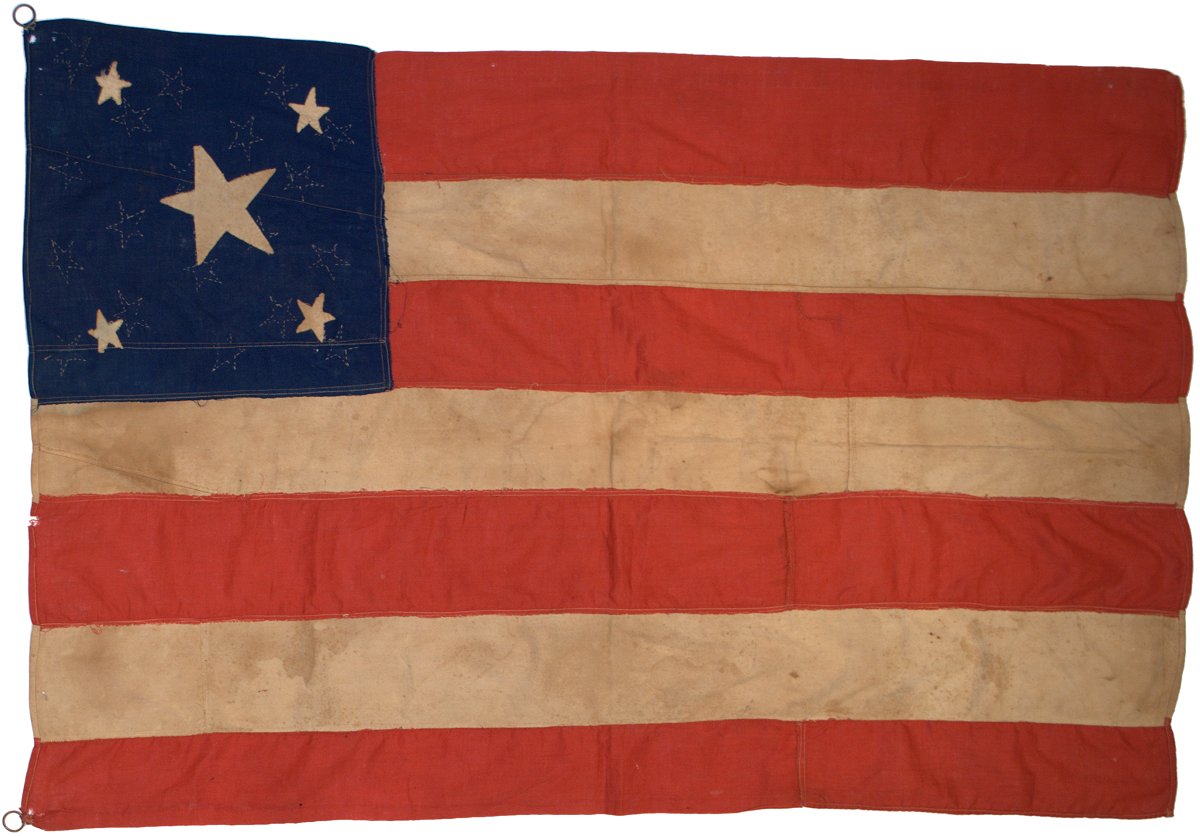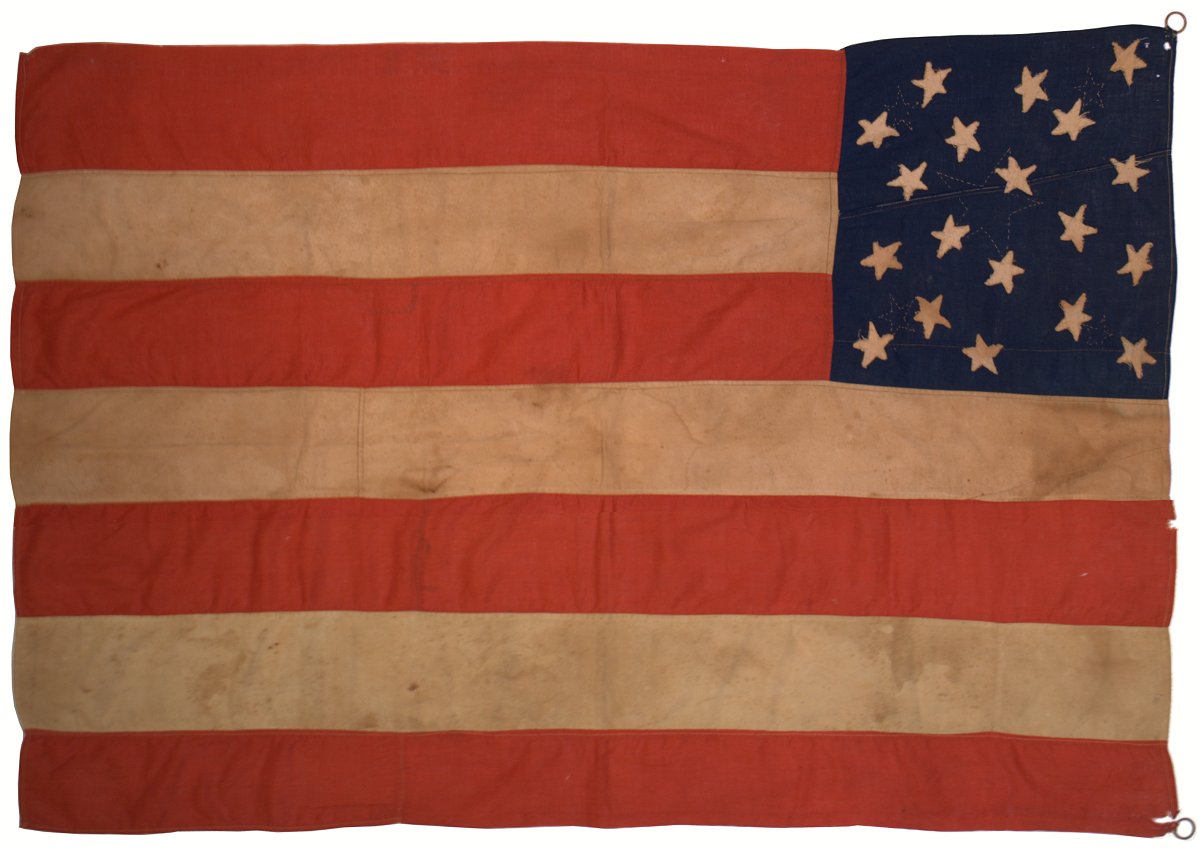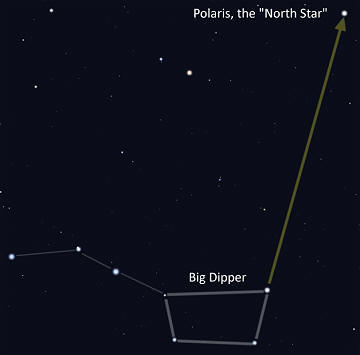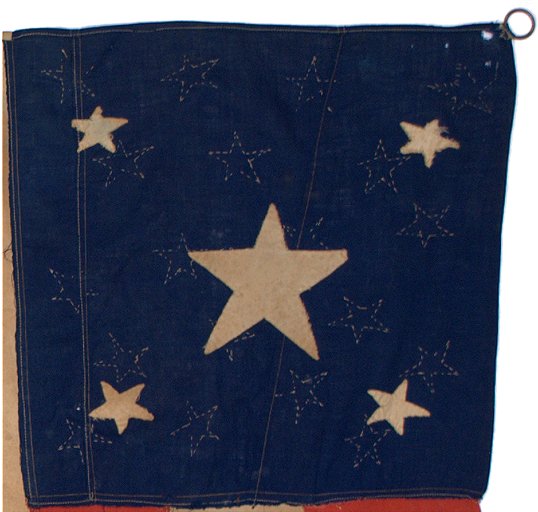
 |
Symbolism
abounds in the American flag, and in many cases, the
meaning behind the symbolism is readily apparent--for
example, 13
stars and 13 stripes for the original 13 colonies, or a
large center star to represent an incoming state.
On rare occasions, however, a flag surfaces that has
deep symbolism that is not readily apparent. Such
is the case with this flag. The flag surfaced in
Michigan, and its construction and materials, including
its aged cotton, metal rings, treadle stitching and hand
sewn stars, are consistent with a flag of the Civil War
era. American flags from the opening years of the war
typically have 34 stars and 13 stripes, and flag makers
often heeded the wishes of President Lincoln to keep the
flag intact, with the full complement of stars. That,
however, is not the case with this fascinating flag.
This
flag has several most unusual traits, each of which
points to its use as an "exclusionary flag",
perhaps designed as
a signal flag for slaves to identify a safe house along
the Underground Railroad. In 1850, Congress passed the
Fugitive Slave Act, which allowed southern bounty
hunters to track down and return escaped slaves that
found their way to the northern states. The law enraged
abolitionists. It was one of
the primary catalysts leading up to the outbreak of the
Civil War. Escaped slaves moving north throughout a
system of abolitionist safe houses were no longer safe
by just reaching the northern-most states. Abolitionists helped many reach Canada where they were
truly out of the reach of southern bounty hunters.
Escaped slaves navigating through the night
learned to identify the four stars in the
bowl of the Big Dipper, to find the edge
stars which point to the North Star, and to
follow the North Star to safety. |
By the time war erupted in 1861, the Union had 34
states, 15 of which were slave states. In 1861, 11
of the slave states declared secession and formed the
Confederacy. In addition to the 11 states that seceded,
four states--Delaware, Maryland, Kentucky, and
Missouri--chose to remain with the Union despite being
slave states. These states were known as the
"Border States". For a period of time, whether these
states
chose to remain loyal to the Union or chose to secede
and join the Confederacy was uncertain.
Regardless, they were not considered safe territories for escaping
slaves, being slave states themselves.
Flags that are
attributed as Civil War "exclusionary flags" usually
have between 18 and 23 stars on them, and often between
9 and 13 stripes. Given that we had between 33 and
36 stars on the American flag during the Civil War
years, and a varying tally of "southern" states that
included 11 seceded states, 4 slave-holding border
states, and 2 Confederate territories, there are many
ways to make the math work to arrive at a particular
star or stripe count. Sometimes, it's a stretch of
the imagination to arrive at meaning, but in this flag's
case, it's very apparent.
The seven stripes of
the flag represent the 13 original colonies, minus the 6
slave-holding original colonies (Delaware, Maryland,
Virginia, North Carolina, South Carolina, and Georgia):
13 - 6 = 7 Free Original Colonies. The 19 stars of the flag's reverse
represent the 34 states at the outbreak of the Civil
War, minus the 15 slave-holding states: 34 - 15 = 19
Free States.
The intentionally trapezoidal canton with four corner
stars and large center star on the
flag's obverse, easy to see from a distance, represents
the Big Dipper bowl and North Star, two known
symbols of the Underground Railroad and guide markers for
sanctuary. The star arrangement would have been
instantly recognizable by fugitive slaves who had
traveled night after night guided north by the North
Star. The confluence of these several traits
in this single flag are not accidental. In all aspects,
the symbolism of the flag unambiguously signifies the
abolitionist movement and the Underground Railroad.
It is a wonderful and extraordinarily rare American flag
of the Civil War era with unparalleled symbolism and
meaning.
 |
 |
|
"We remained
in the woods during the day, and as soon as
darkness overshadowed the earth, we started
again on our gloomy way, having no guide but
the North Star. We continued to travel
by night, and secrete ourselves in woods by
day; and every night, before emerging from
our hiding-place, we would anxiously look
for our friend and leader,--the North Star."
"After dark,
I emerged from the woods into a narrow path,
which led me into the main travelled road.
But I knew not which way to go. I did not
know North from South, East from West.
I looked in vain for the North Star; a heavy
cloud hid it from my view. I walked up
and down the road until near midnight, when
the clouds disappeared and I welcomed the
sight of my friend--truly the slave's
friend--the North Star!"
- William
Wells Brown, 1847
from Narrative of William W. Brown, a
Fugitive Slave. Written by
Himself. Published in Boston, Massachusetts, June 1847 |
|
1
Narrative of William W. Brown, A Fugitive Slave.
Written by Himself. William W. Brown,
Boston, June, 1847
2
The Fugitive Slave's Apostrophe to the North Star.
Reverend John Pierpont, 1839
3 Note: Frederick Douglass' abolitionist
newspaper, first published on December 3, 1847, was
called "The North Star".
|

